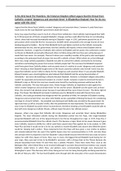Essay
In his 2012 book The Watchers, the historian Stephen Alford argues that the threat from Catholics created ‘dangerous and uncertain times’ in Elizabethan England. How for do you agree with this view?
In his 2012 book The Watchers, the historian Stephen Alford argues that the threat from Catholics created ‘dangerous and uncertain times’ in Elizabethan England. How far do you agree with this view? A top band essay, exemplar material. GCSE History.
[Show more]




